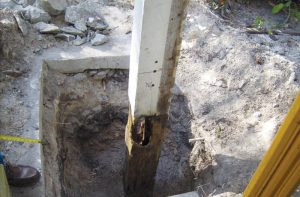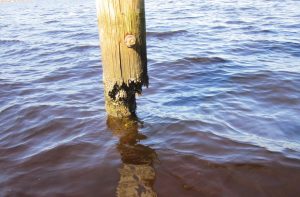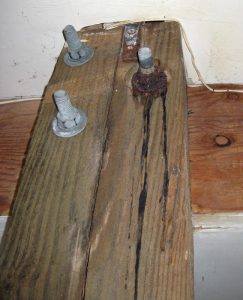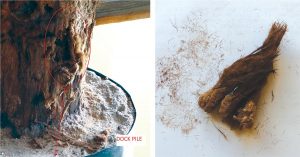It is common in Florida to elevate homes on wood piles in coastal zones A and V. Many of those homes are adjacent to the Atlantic Ocean, the Gulf of Mexico, bays, estuaries, and other bodies containing saltwater. Most of the piles are sheltered under habitable space. Reacting to its environment, the wood has a fuzzy appearance. Why would a wood pile, driven on land or near a body of water, deteriorate at the protected and dry top and not at ground level or the waterline? To understand the cause of “fuzzy wood” and to provide an appropriate repair, we need go back to high school biology and chemistry classes.
Where is Fuzzy Wood Found?
In high school biology class, we learned that all life requires air, food, water, and a sufficiently warm environment or habitat to survive. Naturally, the fungi, mold, insects, and marine life that inhabit and consume wood piles are no different. A wood pile driven into the soil will tend to degrade at or near the ground surface. At no more than a couple of feet below ground, oxygen levels become insufficient to support most life. At a couple feet above ground there may not be enough moisture to support life (Figure 1).
Similarly, piles driven into water will tend to degrade in the tidal zone or at just above the mean water elevation. In the continuously submerged zone, the low oxygen content is only sufficient to support some organisms (e.g. marine borers). Above the waterline, the amount of moisture is limited by drying of the pile (Figure 2).
Many structures near or in saltwater are elevated on wood piles, which are sheltered under habitable space such that the tops of the piles have minimal exposure to weather. One would expect that any damage to the piles would be on the portions of the pile that are exposed to the elements. Therefore, despite the lack of exposure to salt spray, it has been surprising to find that such sheltered piles often have severely corroded bolts connecting the top of the piles to the wood floor framing (Figure 3). Those piles may also have a furry or fuzzy appearance, which some fittingly refer to as “fuzzy wood” (Figure 4). Why would a wood pile, driven on land or near a body of saltwater, deteriorate at the protected top and not at the ground level or the waterline? To understand the cause of “fuzzy wood” and to provide an appropriate repair for that condition, we must examine the internal structure of wood and the response of that structure to saltwater.
Basic Biology and Chemistry
When building with sawn lumber, we must work with what nature has given us. You may recall from high school biology that the cambium layer in a tree is the growth layer, just under the bark, that produces both the inner bark cells of the phloem and the new living wood cells in the xylem. The phloem conducts sugars from the leaves to the roots, sometimes referred to as “shoots to roots.” The xylem is living “sapwood,” which conducts water and substances dissolved in water from the roots to the leaves (“roots to shoots”) and provides support for the tree. The yearly growth in the cambium layer results in annual rings which are visible across the trunk of a felled tree. As new xylem (sapwood) is continually formed, the old xylem dies, hardens, and becomes heartwood at the center of the trunk. Heartwood is durable and more resistant to decay. This is because heartwood has lost much or all its ability to transport liquids due to the blocking of its tube-like structure with gums and resins.
The xylem tube structure is visible as grain when wood is cut vertically down its trunk. (Xylem cells are about the size of animal cells, so one cannot see the individual tubes with the naked eye.) A common analogy used in high school biology classes for xylem is that it acts like a “bundle of straws” running parallel to each other up the trunk. The xylem “straws” allow the wood to draw water upward in a pile in a process known as “wicking.” To wick, it does not matter whether the xylem is in a live tree or a timber pile. What matters is the ability of the xylem straws to transport water.
Furthermore, whether the pile is pressure treated or not does not seem to be a significant factor in wicking. This is likely because the limited depth of penetration of wood preservatives does not significantly inhibit the wicking process in a large wood member. It may also be a result of the replacement of oil-based non-preservatives (e.g. creosote) with more environmentally friendly waterborne wood preservatives (e.g. CCA and ACQ). It has been the author’s experience that the amount of heartwood in a pile appears to have the most significant effect on the ability of the pile to wick, as well as which piles are damaged.
Shifting now to concepts taught in high school chemistry class, we recall that sodium- or potassium-to-chloride ionic bonds are weak, allowing salt molecules to separate in water. As the water evaporates, the salt molecules join to form cubic salt crystals, which have a higher volume than the elements did in solution. The same process occurs in wood. As saltwater that has wicked into a wood pile evaporates, the increase in volume due to the formation of salt crystals generates expansive internal forces that work to split the wood fibers apart. Over time, these expansive forces may damage a polymer called lignin, which binds the xylem tubes together. The damaged wood may gain a “fuzzy” appearance with white salt residue on the surface. This process, known as delignification, is analogous to the spalling of concrete due to the expansive forces resulting from the formation of rust.
Repair Methods
There is little available literature regarding how to address pile wicking and delignification in wood piles in service. It is the author’s observation that, although damage to wood piles from delignification may be unsightly, it may take a long time for significant structural damage (loss of load carrying capacity) to occur. Structural damage is more likely to occur in elements attached to the wicking pile. In such cases, eliminating evaporation sites where damage to connected members might occur may be all that is needed. Bolt holes and bearing points under beams are typically areas where a waterproof coating or an isolation material is needed to separate bolts and beams from the pile.
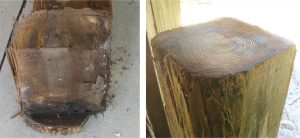
Figure 5. Left: Top of pile removed below a notch for floor beam bearing (note fuzzy wood on the right side). Right: “Fuzzy” wood and annular rings on the bottom portion of a coastal pile cut six inches below a degraded notch for floor beam. (photos are not of the same pile).
Piles with significant structural damage or loss of structural capacity are more challenging to repair. This is because it is expensive, if not impossible, to replace existing driven wood piles “in-kind” under an existing structure. Consequently, shoring and repairing only the degraded top portion of the damaged pile may be preferable to replacing the entire pile. Figure 5 shows a pile with significant damage at the top. However, when the pile was cut off, approximately six inches below the notch for bearing of the floor beams, the lower portion of the pile was found not to be significantly damaged. A splice can also be designed as a moisture barrier between the new top portion of the pile and the existing bottom portion.
Conclusion
Sawn lumber is a unique building material because it is grown and not manufactured. Therefore, we have to work with the unique properties that nature has given us. One of those properties is that wood is consumed by organisms. Another property is that the structure of the xylem in wood acts as a bundle of straws that can transport water. We tend to think that wood damage is only due to an attack by organisms or exposure to chemicals. However, as discussed, it can also be the result of internal mechanical stresses created by the evaporation and subsequent crystallization of salt dissolved in water. The result of those mechanical stresses is damage to the pile in the form of “fuzzy wood.” Understanding and properly diagnosing the cause of damage to a wood pile is needed to provide the proper repair.■

